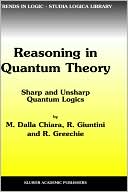

 |

|

The average rating for Reasoning In Quantum Theory based on 2 reviews is 3 stars.
Review # 1 was written on 2014-01-23 00:00:00 Dave Shiwram Dave ShiwramWhat Michael Grenfell and Cheryl Hardy attempt to do in Art Rules is to introduce the reader to the thinking of Pierre Bourdieu about art, specifically visual art. Bourdieu was a French sociologist who often found himself at odds with the structuralist and post-structuralist mandarins of the 60s-80s. His work on art is based on study of the things that surround art in our society--the book discusses at great length early work he did on museums involving taking polls of visitors and non-visitors in various locations. Bourdieu, like most French thinkers, loves inventing jargon, and a lot of the book deals with explaining Bourdieu's complex jargon--habitus (all the specific things about a particular person that give that person an identity--for example, his economic class or his personal sense of style), fields (an area of society relating to one particular thing--like everything that has to do with politics, for example). Habitus and various fields are constantly in dialogue with one another. And in Bourdieu's view, an artist is someone with a particular habitus which is strongly determined by his place in various intersecting fields. These fields bestow on him types of capital--social capital, economic capital, and cultural capital. Cultural capital is useful for artists because it can be used to gain economic capital. In a sense, artists have to convince people occupying certain fields and controlling economic capital that what the artist is doing is "good art". This seems a bit abstract, but Grenfell and Hardy have many very specific examples. And when you read the examples, you kind of say, oh, duh. This artist went to the right art schools and won the right prizes and was collected by the right collectors and museums. In this way, what Bourdieu was saying is not dissimilar to what economist Don Thompson was writing about in the $12 Million Stuffed Shark, except Thompson approached it from an economics point of view instead of a sociological point of view. The thing is, when you apply these ideas to the real world, they start out seeming obvious. I think you can drill down to levels where they are more subtle, but from where I sit, I think the response is, so what if they are obvious. If you look at art history through a Bourdieu-ian lens (or a Thompsonian lens), it is going to look quite different than the kind of art history I grew up with. Frankly, I find it more interesting. It requires that you consider the sources of (social, economic, cultural) capital in a society and identify fields that art exists within. |
Review # 2 was written on 2020-12-14 00:00:00 Kiersten Marcos Kiersten MarcosNot having read anything about Socialism, Marxism or Western feminism before, I picked up the book and was actually quite impressed. However I couldn't go past after half the book was finished because at times the language gets really technical and you will have to be acquainted with some previous philosophies at first. Overall: good one for prospective undergrads who want to try out Socialism courses. |
CAN'T FIND WHAT YOU'RE LOOKING FOR? CLICK HERE!!!